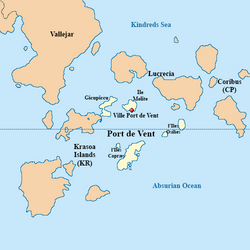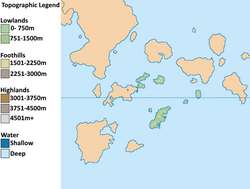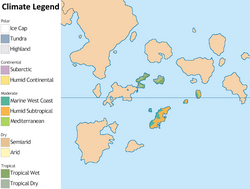Port de Vent: Difference between revisions
m (→Antiquity) Tag: 2017 source edit |
mNo edit summary Tag: 2017 source edit |
||
| Line 104: | Line 104: | ||
|footnotes = | |footnotes = | ||
}} | }} | ||
Port de Vent is an trade island province of [[Burgundie]] in the [[Kindreds Sea]]'s [[Catenias]] archipelago, consisting of five major islands: | Port de Vent is an trade island province of [[Burgundie]] in the [[Kindreds Sea]]'s [[Catenias]] archipelago, consisting of five major islands or island groups: Gicupiccu, Ile Melite, l'Ile Osilies, and l'Iles Capræs. | ||
==History== | ==History== | ||
The islands of the [[Catenias]] archipelago have long been a cultural cross roads. | The islands of the [[Catenias]] archipelago have long been a cultural cross roads. | ||
Revision as of 23:43, 20 May 2024
This article is a work-in-progress because it is incomplete and pending further input from an author. Note: The contents of this article are not considered canonical and may be inaccurate. Please comment on this article's talk page to share your input, comments and questions. |
Trade Islands of Port de Vent | |
|---|---|
 Map of Port de Vent | |
| Nation | |
| Constituent Country equivalent | Burgoignesc Overseas Representative Assembly |
| Geographic Designation | Polar Burgundies |
| Capital | Ville Port de Vent |
| Area | |
| • Total | 62,366.9137 km2 (24,080.0000 sq mi) |
| Population (2030) | |
| • Total | 11,302,230 |
| • Density | 180/km2 (470/sq mi) |
| Demonym(s) | Ventoise |
Port de Vent is an trade island province of Burgundie in the Kindreds Sea's Catenias archipelago, consisting of five major islands or island groups: Gicupiccu, Ile Melite, l'Ile Osilies, and l'Iles Capræs.
History
The islands of the Catenias archipelago have long been a cultural cross roads.
Prehistory
Archeological evidence suggests that humans first settled permanently on the islands of modern Port de Vent and the Krasoa Islands around 4200 BCE. The Sundaic, Alitros sea people of the Glaistic civilization, established their first settlements along the coast, carving rudimentary dwellings into the cliffs. Their lives revolved around fishing, hunting, and navigating the treacherous currents of the archipelago's straits.
However, around 1100 BCE, Sundaic legends speak of encountering the Sky People, beings of immense stature who arrived in colossal vessels and possessed advanced knowledge, likely Adonerii. The Sundaic, initially wary, eventually formed a tentative connection. The Sky People shared some of their knowledge, influencing the island's intricate water channels and the unique architectural style of some Sundaic structures, incorporating the Latinic architecture into Glaistic megaliths. The islands that make up Port de Vent and the Krasoa Islands became the southwestern extent of the Adonerum and therefore remained a peripheral place meaning that no great effort was put into contralizing or enculutrating that Sundaics. Evidence suggests that Glaistic masks, with their enigmatic smiles and intricate details, may have been adopted into the Adonerii religious and social rituals, later evolving into symbols of power and leadership. Around 600 BCE, Adonerii legends speak of a devastating tsunami that impacted the Catenias archipelago. The Sundaic outposts across the region, including those on Port de Vent, were abandoned or destroyed. The Sundaics vanished from the historical record, but DNA evidence shows a pattern of intertribal breeding that pre-supposes that the Sundaics didn't disappear as much as they ceased to be unique and were more than likely just merged into the existing Adonerii identity. After the disaster, competition for limited resources, competition for fertile land, and fishing grounds grew between different Adonerii city-states, led to the rise of despotates vying for dominance. 600-200 BCE was marked by terrible inter-city violence, and slavery and piracy emerged as key aspects of southwestern Catenias Adonerii power structures and society.
Antiquity
Antiquity in Port de Vent covers from the time of the Great Tsunami around 607 BCE through the 4th century CE and was marked by an increasingly centralizing series of Latinic-states in the Catenias archipelago. The northern islands of Port de Vent (Gicupiccu, Ile Melite, and Ile Gran Osilie) were conquered and ruled by the Emerita Maris (modern-day Lucrecia), starting around 250 BCE.
Geography

Climate and environment

Port de Vent has a tropical wet and dry climate.
- Geography_of_New_Caledonia#Climate (reference)
Economy
Standard of living
Employment
Agriculture
Agrinergie
Main article: Agrivoltaics
Tourism and hospitality
Resorts
Cruises
Recreation
Key tourism and hospitality companies
Logging/Mineral extraction
Paper milling
Mining
Drilling
Fishing
Fishing and fisheries
Distant-water fishing fleet
Local commercial fishing
Aquaculture
Main article: Aquaculture Aquatic life farming, in general
- Pisciculture- fish farming
- Mariculture- Saltwater fish farming
- shrimp farming
- oyster farming
- algaculture
Artisanal/heritage industries
Science and research
Finance
Manufacturing
Industrial recycling
Creative industries
Sports and leisure
Trade
| Port Nova Martillia | |
|---|---|
 | |
| Location | |
| Country | |
| Details | |
| Opened | 1949 |
| Employees | 550 |
| Statistics | |
| Vessel arrivals | 179 |
| Annual cargo tonnage | 805.219 tonnes |
| Annual revenue | ₮25 million |
Transshipment
Main article: Transshipment
Customs and tariffs
Main article: Customs
